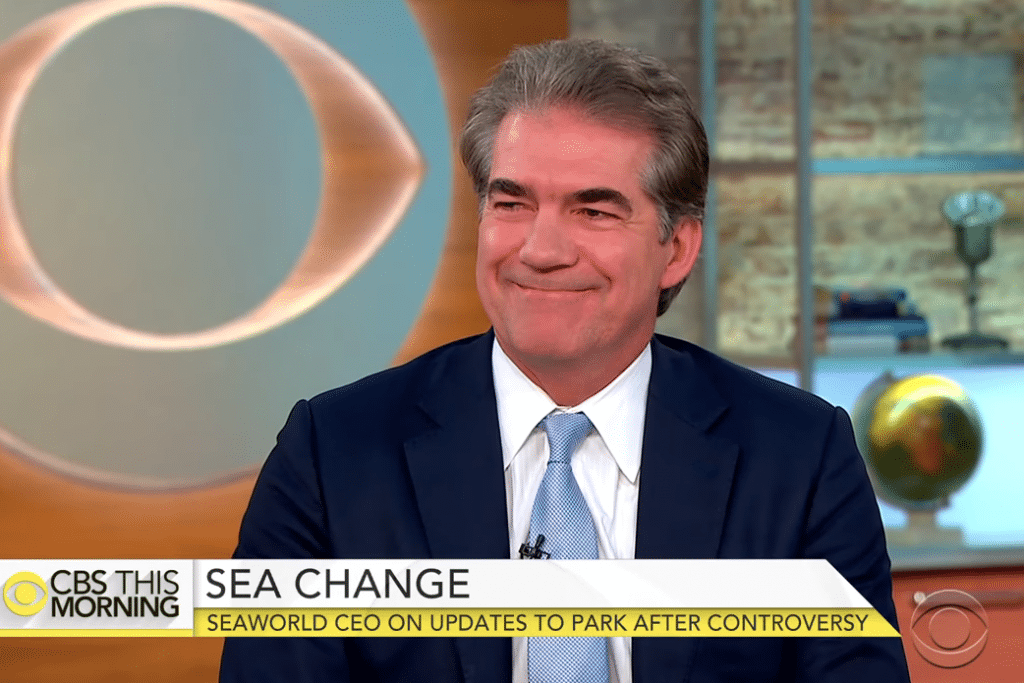Skift Take
This was probably inevitable. Joel Manby tried to turn the company around, but his efforts failed to do the trick. Executives say they plan to continue his strategies, but we wonder how much will change once a permanent new CEO is named.
Joel Manby, the outsider named to rescue SeaWorld three years ago, has stepped down as president and CEO, the company announced Tuesday.
His replacement, at least for now, is a longtime company insider. John Reilly, the chief parks operation officer who once led the SeaWorld San Diego park, is interim CEO until a new leader is chosen by the board of directors.
Manby’s resignation, which was effective Monday, came as the company announced another year of losses and declining attendance. SeaWorld has struggled since the 2013 release of the documentary Blackfish, which was highly critical of the company’s treatment of captive orcas. The company is under federal investigation for publicly downplaying the film’s impact.
“Over the past three years, Joel has worked tirelessly to strengthen SeaWorld’s position as a company that combines entertainment, education, and its important mission to protect marine life and the oceans,” Yoshikazu Maruyama, interim executive chairman, said in a statement. “Our improving fourth quarter and positive year-to-date trends give us confidence that the steps we have taken position us well for 2018.”
Attendance fell by 5.5 percent in 2017 to 20.8 million; it was the second straight year of attendance loss. Revenue dropped from $1.34 million to $1.26 billion, the lowest number since at least 2012. And the net loss grew from $12.5 million to $202.4 million due to a non-cash impairment charge.
Fourth-quarter revenue dropped slightly to $265 million, while net loss increased from $12 million in 2016 to $20 million in 2017. Attendance dropped 2.7 percent. Still, the company said results were better than expected for the three months ending Dec. 31 and trends in the quarter “showed improvement versus the first nine months of the year.” So far this year, season pass sales and attendance are up compared to 2017, the company said.
In a press release announcing the changes Tuesday, SeaWorld highlighted its “improving operating and financial performance trends along with substantial progress in enhancing the strategic positioning of the company’s mission-driven brand.”
The board and Manby, according to the statement, “agreed that this is the right time to identify a new CEO as the company enters its next phase of intensified focus on execution and growth.”
Manby joined SeaWorld in April of 2015. The following year, he announced the company would end its captive orca breeding program and change its killer whale entertainment shows.
He put a five-point plan into place, which included shifting away from animal entertainment to “experiences that matter” as well as addressing reputational issues; investing in parks; focusing on strategic revenue growth; and enhancing financial discipline. SeaWorld Entertainment has a portfolio of 12 theme and water parks under brands including SeaWorld, Busch Gardens, and Sesame Place.
“I am so proud of this company and all we have accomplished to position SeaWorld for continued success by providing fun and truly meaningful experiences that connect our guests to the natural world,” Manby said in a statement. “John is an ideal choice to lead the company, and I feel confident that I leave SeaWorld in incredibly capable hands.”
During an earnings call Tuesday morning, Reilly said he planned to carry on Manby’s strategy. But he also said the company shouldn’t shy away from talking about its animal collection as an example of what makes its SeaWorld parks different, especially in competitive markets such as Orlando.
“We’ve competed successfully there over time for decades and we really believe that we have to do a better job talking about our differentiated product,” he said. “We have an irreplaceable animal collection. It’s a unique guest experience that you can’t find in any of the [other] Orlando parks. So I think what you’ll see us do going forward is better communicating the differentiators that set us up well versus our competitors.”
To be sure, the company is investing in non-animal parts of the business as well: new rides, attractions, or events at almost every park this year. And the company is devoting significant resources to a strategic marketing campaign.
But Reilly’s desire to highlight animals could also carry a risk. The attention that Blackfish brought — and the drop in attendance that followed — sent SeaWorld into a tailspin from which it has still not recovered.
Dennis Speigel, president of consulting firm International Theme Park Services, said SeaWorld is dealing with a “real convoluted, problematic five-pronged fork” that includes issues around branding, image, product, pricing, and competition.
“All of these things have to be addressed and cross the finish line at the same time,” he said.
Speigel said that if the company is going to highlight its animal collection, it must take that approach with care.
“Getting the right combination to the lock for the use of the animals, that has to be done understood and implemented correctly because of the horrible publicity they’ve had,” he said.
The Daily Newsletter
Our daily coverage of the global travel industry. Written by editors and analysts from across Skift’s brands.
Have a confidential tip for Skift? Get in touch
Tags: earnings, seaworld, theme parks
Photo credit: Joel Manby resigned as SeaWorld CEO this week, the company announced Tuesday. He is pictured in an appearance on CBS.
